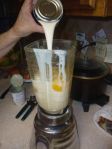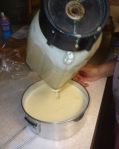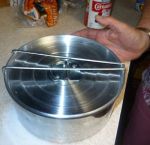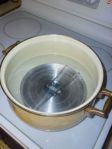This week Carmen and I made beef chimichangas. We actually used this opportunity to multi-task since we made the beef chimichangas mini, a perfect snack for the upcoming family party. So Carmen got the help she needed making 200 mini chimis for the party, and I got more cooking knowledge and a blog topic.
Interestingly enough the chimichanga has a story of originating from right here in Tucson, Arizona. As the story goes a woman affiliated with the oldest mexican food restaurant, El Charro, accidentally dropped a burrito in the fryer. In her frustration she started to yell “chingado,” a spanish curse word, but mid-sentence she changed to chimichanga. Hence was born the deep-fried burrito.
Though this story seems a little far-fetched, it is a popular fable linked to the chimichanga that is popular in mexican food restaurants across Southwest Arizona.
So now lets start making our own deep-fried mistakes.

Carmen starts by browning the beef
You will need to cook the ground beef in a skillet with hot oil. Once the beef is browned, you will add the chopped onion and and minced garlic to the beef.
While the beef is cooking with the vegetables, you will heat 3 potatoes seperately in the microwave for 3 minutes each. You can leave the skins on the potatoes and once they are cooked the skin should peel off easily and the potatoes should pretty much crumble apart.
Once you have peeled them you will mash them with your fingers as you add them to the beef mixture. Mix and smash the potatoes into the beef until there are no big chunks and it is evenly mixed.
Cut whole jalapenos into pieces, remove the seeds, and add to the beef. The best option for this is just to find whatever is the cheapest brand of canned whole jalapenos.

Buy canned whole jalapenos
You can customize how spicy your recipe is by adding more jalapenos to the recipe or leaving some seeds on the chile.
You will also want to add salt, pepper, and oregano to the beef for the final touch. As much or as little of each as you like. This recipe will be salty on its own without much help from the salt, so be sure to add in small increments, tasting after each time.
Okay now the meat is ready and you can start the chimi-making process. You will need some room for this part. Carmen and I cleared off her kitchen table and needed all of the space to set up the production line for the chimis.
Besides the skillet of beef on the table, you will need a small bowl with one scrambled egg and some milk mixed together. This is what you will brush on the end of the tortilla to keep the chimi rolled.
Obviously you will also need flour tortillas. Carmen and I used large tortillas, they are also sometimes called burrito tortillas.
Fold a tortilla in half and then in half again, forming a triangle. Using a pair of kitchen scissors, cut the triangle down the center. Then use the scissors to cut the folds to make them all single smaller triangles.

Fold in 1/2, 1/2 and then cut in 1/2
Heat the triangles in groups of about 8 in the microwave for 30 seconds. It is important to warm the tortillas first to keep them from cracking when you roll the chimichangas.
Carmen warns to make sure the tortilla doesn’t crack and that the beef mixture isn’t exposed, because it will make a mess in your fryer if the beef can get out.
If you don’t get good quality tortillas they will crack no matter how much you warm them. It is sometimes hard to tell which tortillas are good quality so I recommend trying to roll the tortillas in the bag at the grocery store to see if they crack. You might look strange in the store, but it is better than having to go back to the grocery store after you roll your first chimichanga.
Okay back to rolling the mini chimichangas.
The first thing you want to do is to put some of the egg mixture on the point of the triangle. Carmen uses her fingers, dipping them in the bowl and then brushing her fingers across the end. I preferred to just dip the end of the triangle in the mixture and keep my fingers out of it. But no matter how you decide to do it, you will need to get the tip adequately moist so that it will stick to the chimi and stay rolled.

Start at the wide end and roll towards the point
Starting at the wide end, put about an inch of the beef mixture centered an inch in from the end of the tortilla. You will want to fold the end over the beef, and once you have covered the beef, fold over the ends on either side. Continue rolling the tortilla until you get to the tip, sealing the chimi closed.
Repeat these steps until all the beef mixture has been used. As you are doing this, it might be a good idea to set up your deep fryer and let the oil get hot. If you don’t have a deep fryer, well then I don’t think you can make this recipe. Sorry.
Once you have rolled all of your chimis and the oil in your fryer has gotten hot, you will want to lay them flat in the bottom of your frying basket and submerge the basket in the oil. Watch the chimis and check them occasionally to keep them from getting too fried, but it should be for about 2-3 minutes. Once the chimis are light brown, pull out the basket and after straining out the oil put them in a container or on a plate.
This is probably the most important part…wait for the chimis to cool before you eat them! I know you will be excited and I promise they will smell really good, but let them cool. Remember that not only the outside needs to cool, but the inside as well.

Buen Provecho!
So if all of this made sense, and you’re interested in trying them yourself, then buy the ingredients listed below and good luck! I promise it’s not as hard it sounds.
Beef Chimichangas:
ground beef (as much as you want – we used about 4 lbs to make the first 100 chimichangas)
potatoes (I would say one small potato for each pound of beef)
1/4 onion for each lb of beef
1 clove of garlic minced for each lb of beef
jalapenos – really as much or as little as you want, or even none at all
*You will also need one egg and about 2 tablespoons of milk
Carmen’s tips:
- You don’t have to use beef for chimichangas. You can also use beans, cheese, chicken, etc.
- It is just as easy to make regular size chimis using the same technique, but a full-size tortilla instead.


 Unfortunately, she bought her pan in Hermosillo, Mexico. But I found where you can buy your own for not very much.
Unfortunately, she bought her pan in Hermosillo, Mexico. But I found where you can buy your own for not very much. 







 At any point during this I could’ve just stopped her and asked what we were making, but I didn’t want to seem foolish and I was kind of enjoying the mystery.
At any point during this I could’ve just stopped her and asked what we were making, but I didn’t want to seem foolish and I was kind of enjoying the mystery.






 Now you will need to chop 1/4 green pepper and 1/2 an onion. You will also mince 1 clove of garlic.
Now you will need to chop 1/4 green pepper and 1/2 an onion. You will also mince 1 clove of garlic. 








